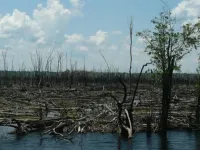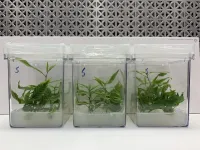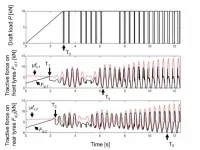(Press-News.org) Agência FAPESP – White-sand savannas are expanding in the heart of the Amazon as a result of recurring forest fires, according to a study published in the journal Ecosystems.
The study was supported by FAPESP, and conducted by Bernardo Monteiro Flores, currently a postdoctoral fellow in ecology at the Federal University of Santa Catarina (UFSC) in Brazil, and Milena Holmgren, a professor in the Department of Environmental Sciences at Wageningen University in the Netherlands.
“The edges of the Amazon Rainforest have long been considered the most vulnerable parts owing to expansion of the agricultural frontier. This degradation of the forest along the so-called ‘deforestation arc’ [a curve that hugs the southeastern edge of the forest] continues to occur and is extremely troubling. However, our study detected the appearance of savannas in the heart of the Amazon a long way away from the agricultural frontier,” Flores told Agência FAPESP.
The authors studied an area of floodplains on the middle Negro River near Barcelos, a town about 400 km upstream of Manaus, the capital of Amazonas state, where areas of white-sand savanna are expanding, although forest ecosystems still predominate. They blame the increasing frequency and severity of wildfires in the wider context of global climate change.
“We mapped 40 years of forest fires using satellite images, and collected detailed information in the field to see whether the burned forest areas were changing,” Flores said. “When we analyzed tree species richness and soil properties at different times in the past, we found that forest fires had killed practically all trees so that the clayey topsoil could be eroded by annual flooding and become increasingly sandy.”
They also found that as burnt floodplain forest naturally recovers, there is a major shift in the type of vegetation, with native herbaceous cover expanding, forest tree species disappearing, and white-sand savanna tree species becoming dominant.
Less resilient
Where do the savanna tree species come from? According to Flores, white-sand savannas are part of the Amazon ecosystem, covering about 11% of the biome. They are ancient savannas and very different from the Cerrado with its outstanding biodiversity, yet even so they are home to many endemic plant species. They are called campinas by the local population. Seen from above, the Amazon is an ocean of forest punctuated by small islands of savanna. The seeds of savanna plants are distributed by water, fish and birds, and are more likely than forest species to germinate when they reach a burnt area with degraded soil, repopulating the area concerned.
“Our research shows native savanna cover is expanding and may continue expanding in the Amazon. Not along the ‘deforestation arc’, where exotic grasses are spreading, but in remote areas throughout the basin where white-sand savannas already exist,” Flores said.
It is important to stress that in the Amazon floodplain forest is far less resilient than upland terra firma forest. It burns more easily, after which its topsoil is washed away and degrades much more rapidly. “Floodplain forest is the ‘Achilles heel’ of the Amazon,” Holmgren said. “We have field evidence that if the climate becomes drier in the Amazon and wildfires become more severe and frequent, floodplain forest will be the first to collapse.”
These two factors – a drier climate, and more severe and frequent fires – are already in play as part of the ongoing climate change crisis. The study shows that wildfires in the middle Negro area during the severe 2015-16 El Niño burned down an area seven times larger than the total area destroyed by fire in the preceding 40 years.
“The additional loss of floodplain forest could result in huge emissions of carbon stored in trees, soil and peatlands, as well as reducing supplies of resources used by local people, such as fish and forest products. The new discoveries reinforce the urgency of defending remote forest areas. For example, a fire management program should be implemented to reduce the spread of wildfires during the dry season,” Flores said.
The article “White-sand savannas expand at the core of the Amazon after forest wildfires” is at: link.springer.com/article/10.1007%2Fs10021-021-00607-x.
Forest fires drive expansion of savannas in the heart of the Amazon
Researchers analyzed the effects of wildfires on plant cover and soil quality in the last 40 years. The findings of the study show that the forest is highly vulnerable even in well-conserved areas far from the 'deforestation arc'.
2021-05-04
ELSE PRESS RELEASES FROM THIS DATE:
Researchers identify potential combination therapy for aggressive lung cancer
2021-05-04
FINDINGS
A new study by researchers at the UCLA Jonsson Comprehensive Cancer Center has identified a novel combination therapy to potentially help overcome resistance to immunotherapy in people diagnosed with advanced lung cancer. The combination approach uses immune checkpoint inhibitors with ATRA, a safe medication that is widely used to treat leukemia. The team found the combination therapy led to eradication of over 70% of tumors when tested in mice with LKB1-deficient lung cancer. It also generated durable tumor-specific immunity.
BACKGROUND
Immune checkpoint inhibitors have substantially ...
One step closer to efficient cannabis production
2021-05-04
As nurseries and garden centers fill up with spring landscaping plants, home gardeners owe a lot to a technique called micropropagation, which has proven beneficial to many plants - perhaps soon to include cannabis, thanks to work by UConn researchers in the College of Agriculture, Health, and Natural Resources.
Micropropagation is a technique used for growing large quantities of new plants from fewer "parent" plants, yielding clones with the same, predictable qualities. The cannabis (Cannabis sativa) industry, however, has been largely left out of this beneficial technique, because this species of plant is extremely difficult to micropropagate.
Researchers from UConn - including Associate Professor Jessica Lubell-Brand, Ph.D. student Lauren Kurtz, and Professor Mark ...
Forty years of nursing science in HIV/AIDS: JANAC marks progress and challenges
2021-05-04
May 4, 2021 - From the very beginning of the AIDS epidemic in 1981, nurses have been at the forefront of patient care, advocacy, and research. But even in the age of antiretroviral therapy and pre-exposure prophylaxis, many challenges remain in reducing the impact of HIV and AIDS, according to the special May/June issue of END ...
Bringing up baby: A crocodile's changing niche
2021-05-04
Relatives of the giant crocodile might have been kings of the waterways during the Cretaceous period, eating anything--including dinosaurs--that got a little too close to the water's edge, but the largest of these apex predators still started off small. Figuring out how these little crocs grew up in a world surrounded by giants is no small task. Now crocs fossils from Texas are shedding light on how these animals changed their diets as they grew, helping them find a place of their own in environments alongside their bigger, badder relatives.
According to the study, published by Cambridge University Press, the crocodiless in question are members of the Deltasuchus motherali and lived along the coastline of Texas 96 million years ...
Why does heart scarring cause abnormal rhythms in some people but not others?
2021-05-04
Scientists have shed light on why some people who have a stroke do not also have abnormal heart rhythms, even though their hearts contain similar scar tissue.
Their results, published today in eLife, could help identify the best treatments for people who might be at risk of recurrent stroke, new heart disorders, or both.
Strokes are often caused by abnormal blood flow resulting from rapid, irregular beating in the upper chamber of the heart. This is also called atrial fibrillation (AFib). But some people have strokes that appear to have been caused by the heart, ...
Endothelial function biomarker bio-ADM for risk stratification and management of COVID-19 patients
2021-05-04
Aachen, Germany and Hennigsdorf/Berlin, Germany, May 4, 2021 - German University Hospital Uniklinik RWTH Aachen ("Uniklinik RWTH Aachen") and diagnostics company SphingoTec GmbH ("SphingoTec") today announced that the endothelial function biomarker bio-ADM aids in the early risk stratification and management of patients suffering from severe COVID-19, in need for escalated intensive care treatment (1). A team lead by the clinical researchers at Uniklinik RWTH Aachen has shown that high bio-ADM levels indicate the severity of the acute respiratory distress ...
Staying down on the farm
2021-05-04
Tokyo, Japan - Researchers at Tokyo University of Agriculture and Technology (TUAT) modeled the dynamic instability--the so-called "power hop"--that can cause uncontrollable bouncing and damage tractors when they plow dry ground. The team found that self-excited oscillations can arise when the tractor pushes against the ground.
Plowing a field on a tractor may seem like a serene occupation, but sudden vibrations can grow unexpectedly and threaten to topple you under certain conditions. The problem is that in nonlinear systems with coupled components, as with a mechanical tractor, ...
Closing in on state-of-the-art semiconductor solar cells
2021-05-04
A synthetic approach that improves absorber layers in perovskite solar cells could help them achieve their full potential and draw closer to the performance of leading gallium arsenide devices.
Solar cells that rely on perovskite thin films to capture sunlight are the fastest growing photovoltaic technology. Cheaper and easier to manufacture and incorporate into devices than conventional semiconductors, lead halide perovskites also effectively absorb visible light and display long charge carrier diffusion lengths -- an indicator of their ability to maintain light-induced electrons and holes separation and facilitate charge transport.
Performance ...
Aryl hydrocarbon receptor suppresses immunity to oral cancer through immune checkpoint regulation
2021-05-04
A new Boston University School of Public Health (BUSPH) study has identified for the first time how the aryl hydrocarbon receptor (AhR), an environmental chemical receptor, drives immunosuppression in oral squamous cell carcinoma (OSCC)--and that its removal from malignant cells can result in tumor rejection.
Published in the journal Proceedings of the National Academy of Sciences, the study findings provide new insight into the biology of cancer immunosuppression, and identify a new target for cancer immunotherapy treatment.
Immune checkpoint inhibitors (immunotherapy drugs) are some of the most important treatments that have emerged for treating many cancers, including OSCC. Targeting immune checkpoint molecules such as PD-1, ...
Polarization and mobilization on social media affect infection figures
2021-05-04
Measures to contain the Corona pandemic are the subject of politically charged debate and tend to polarize segments of the population. Those who support the measures motivate their acquaintances to follow the rules, while those who oppose them call for resistance in social media. But how exactly do politicization and social mobilization affect the incidence of infection? Researchers at the Max Planck Institute for Human Development have examined this question using the USA as an example. Their findings were published in Applied Network Science.
Limit crowds, keep a safe distance, and wear masks. Such non-pharmaceutical ...
LAST 30 PRESS RELEASES:
The Ceramic Society of Japan’s Oxoate Ceramics Research Association launches new international book project
Heart-brain connection: international study reveals the role of the vagus nerve in keeping the heart young
Researchers identify Rb1 as a predictive biomarker for a new therapeutic strategy in some breast cancers
Survey reveals ethical gaps slowing AI adoption in pediatric surgery
Stimulant ADHD medications work differently than thought
AI overestimates how smart people are, according to HSE economists
HSE researchers create genome-wide map of quadruplexes
Scientists boost cell "powerhouses" to burn more calories
Automatic label checking: The missing step in making reliable medical AI
Low daily alcohol intake linked to 50% heightened mouth cancer risk in India
American Meteorological Society announces Rick Spinrad as 2026 President-Elect
Biomass-based carbon capture spotlighted in newly released global climate webinar recording
Illuminating invisible nano pollutants: advanced bioimaging tracks the full journey of emerging nanoscale contaminants in living systems
How does age affect recovery from spinal cord injury?
Novel AI tool offers prognosis for patients with head and neck cancer
Fathers’ microplastic exposure tied to their children’s metabolic problems
Research validates laboratory model for studying high-grade serous ovarian cancer
SIR 2026 delivers transformative breakthroughs in minimally invasive medicine to improve patient care
Stem Cell Reports most downloaded papers of 2025 highlight the breadth and impact of stem cell research
Oxford-led study estimates NHS spends around 3% of its primary and secondary care budget on the health impacts of heat and cold in England
A researcher’s long quest leads to a smart composite breakthrough
Urban wild bees act as “microbial sensors” of city health.
New study finds where you live affects recovery after a hip fracture
Forecasting the impact of fully automated vehicle adoption on US road traffic injuries
Alcohol-related hospitalizations from 2016 to 2022
Semaglutide and hospitalizations in patients with obesity and established cardiovascular disease
Researchers ‘listen in’ to embryo-mother interactions during implantation using a culture system replicating the womb lining
How changing your diet could help save the world
How to make AI truly scalable and reliable for real-time traffic assignment?
Beyond fragmented markets: A new framework for efficient and stable ride-pooling
[Press-News.org] Forest fires drive expansion of savannas in the heart of the AmazonResearchers analyzed the effects of wildfires on plant cover and soil quality in the last 40 years. The findings of the study show that the forest is highly vulnerable even in well-conserved areas far from the 'deforestation arc'.


